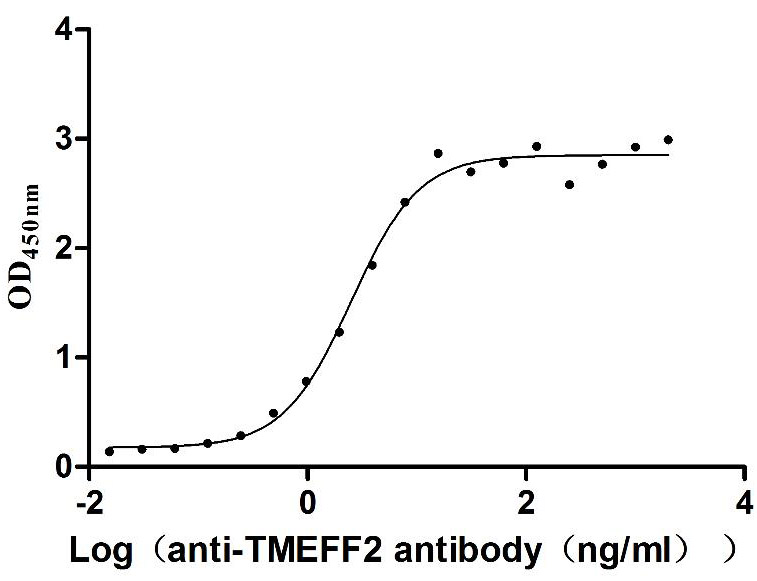Recombinant Mouse Protein sprouty homolog 1 (Spry1)
-
中文名称:小鼠Spry1重组蛋白
-
货号:CSB-YP870757MO
-
规格:
-
来源:Yeast
-
其他:
-
中文名称:小鼠Spry1重组蛋白
-
货号:CSB-EP870757MO
-
规格:
-
来源:E.coli
-
其他:
-
中文名称:小鼠Spry1重组蛋白
-
货号:CSB-EP870757MO-B
-
规格:
-
来源:E.coli
-
共轭:Avi-tag Biotinylated
E. coli biotin ligase (BirA) is highly specific in covalently attaching biotin to the 15 amino acid AviTag peptide. This recombinant protein was biotinylated in vivo by AviTag-BirA technology, which method is BriA catalyzes amide linkage between the biotin and the specific lysine of the AviTag.
-
其他:
-
中文名称:小鼠Spry1重组蛋白
-
货号:CSB-BP870757MO
-
规格:
-
来源:Baculovirus
-
其他:
-
中文名称:小鼠Spry1重组蛋白
-
货号:CSB-MP870757MO
-
规格:
-
来源:Mammalian cell
-
其他:
产品详情
-
纯度:>85% (SDS-PAGE)
-
基因名:
-
Uniprot No.:
-
别名:Spry1; Protein sprouty homolog 1; Spry-1
-
种属:Mus musculus (Mouse)
-
蛋白长度:full length protein
-
表达区域:1-313
-
氨基酸序列MDSPSQHGSH TSLVVIQPPA VEGRQRLDYD RDTQPATILS LDQIKAIRGS NEYTEGPSVA RRPAPRTAPR PEKQERTHEI IPANVNSSYE HRPASHPGNA RGSVLSRSTS TGSAASSGSS SSVSSEQGLL GRSPPTRPIP GHRSDRVIRT QPKQLLVEDL KASLKEDPTQ HKFICEQCGK CKCGECTAPR ALPSCLACDR QCLCSAESMV EYGTCMCLVK GIFYHCSNDD DGGSYSDNPC SCSQSHCCSR YLCMGALSLC LPCLLCYPPA KGCLKLCRGC YDWTHRPGCR CRNSNTVYCK LESCPSRAQG KLS
-
蛋白标签:Tag type will be determined during the manufacturing process.
The tag type will be determined during production process. If you have specified tag type, please tell us and we will develop the specified tag preferentially. -
产品提供形式:Lyophilized powder
Note: We will preferentially ship the format that we have in stock, however, if you have any special requirement for the format, please remark your requirement when placing the order, we will prepare according to your demand. -
复溶:We recommend that this vial be briefly centrifuged prior to opening to bring the contents to the bottom. Please reconstitute protein in deionized sterile water to a concentration of 0.1-1.0 mg/mL.We recommend to add 5-50% of glycerol (final concentration) and aliquot for long-term storage at -20℃/-80℃. Our default final concentration of glycerol is 50%. Customers could use it as reference.
-
储存条件:Store at -20°C/-80°C upon receipt, aliquoting is necessary for mutiple use. Avoid repeated freeze-thaw cycles.
-
保质期:The shelf life is related to many factors, storage state, buffer ingredients, storage temperature and the stability of the protein itself.
Generally, the shelf life of liquid form is 6 months at -20°C/-80°C. The shelf life of lyophilized form is 12 months at -20°C/-80°C. -
货期:Delivery time may differ from different purchasing way or location, please kindly consult your local distributors for specific delivery time.Note: All of our proteins are default shipped with normal blue ice packs, if you request to ship with dry ice, please communicate with us in advance and extra fees will be charged.
-
注意事项:Repeated freezing and thawing is not recommended. Store working aliquots at 4°C for up to one week.
-
Datasheet :Please contact us to get it.
靶点详情
-
功能:Inhibits fibroblast growth factor (FGF)-induced retinal lens fiber differentiation, probably by inhibiting FGF-mediated phosphorylation of ERK1/2. Inhibits TGFB-induced epithelial-to-mesenchymal transition in lens epithelial cells.
-
基因功能参考文献:
- Study demonstrated that Spry1 has a role in supporting mitogen-induced vascular hyperplasia, at least in part by promoting Akt/Rb signaling and increasing mitogen-induced cyclinD1 expression and decreasing p27Kip1 expression. PMID: 29105817
- Loss of Spry1/2 enhances the survival of effector CD8+ T cells and results in the formation of more protective memory cells. Deleting Spry1/2 in antigen-specific CD8+ T cells may have therapeutic potential for enhancing the survival and functionality of effector and memory CD8+ T cells in vivo. PMID: 30126987
- Inhibition of miR-29b could attenuate atherosclerosis by inhibiting the SPRY1/MAPK signaling pathway and inflammation in aorta. PMID: 29398368
- modulation of stromal paracrine signaling and extracellular matrix remodeling by SPRY1 regulates mammary epithelial morphogenesis during postnatal development. PMID: 27621461
- Here, we present a novel mouse model of pheochromocytoma consisting of double-heterozygous mice for Pten and Sprouty1 (Spry1), which leads to pheochromocytomas that appear at earlier onset and grow at a higher rate than those from Pten+/- mice. PMID: 26830459
- Cosuppression of Sprouty and Sprouty-related negative regulators of FGF signalling in prostate cancer PMID: 26075267
- Sprouty gain of function disrupts lens cellular processes and growth by restricting receptor tyrosine kinase signaling. PMID: 26375880
- In vivo analysis of thyroid glands from Spry1 knockout mice reveals that Spry1 induces a senescence-associated secretory phenotype via activation of the NFkappaB pathway. PMID: 24270409
- showed that hSpry1 overexpression prevents VEGF secretion PMID: 24510305
- Spry1 and Spry2 coordination is required for normal development of the external genitalia in mice PMID: 24361260
- conjunctival epithelial Spry1 and Spry2 redundantly promote eyelid closure. PMID: 24055172
- Findings demonstrate that Pokemon suppresses Sprouty1 expression through a miR-21-mediated mechanism, affecting the growth and proliferation of liver cancer cells. PMID: 23355454
- ISG15 mRNA expression and IFN-dependent antiviral responses are enhanced in Spry1,2,4 triple knock-out mouse embryonic fibroblasts, consistent with negative feedback regulatory roles for Spry proteins in IFN-mediated signaling. PMID: 23074222
- When Spry1 and Spry2 loss-of-function occurs in the context of heterozygosity for a null allele of the tumor suppressor gene Pten, there is a striking increase in prostatic intraepithelial neoplasia and evidence of neoplastic invasion. PMID: 23150596
- To determine whether modulating RTK signalling may overcome the abnormal nephrogenesis of Fraser syndrome, we introduced a single null Sprouty1 allele into Fras1(bl/bl) mice, reducing the ureteric bud's expression of this anti-branching molecule. PMID: 23064016
- investigation of role of Spry1: Overexpression of Spry1 in transgenic mice leads to lower body fat, reduced bone loss, and normal metabolic function (i.e., prevents liver steatosis/glucose intolerance) compared with Spry1-negative transgenic mice. PMID: 22142492
- findings identify Spry1 as a candidate tumor-suppressor gene in medullary thyroid carcinoma PMID: 22158037
- Studies implicate Spry1 as a novel regulator of erythropoiesis during anemia, transducer of EPO/EPOR signals, and candidate suppressor of Jak2 activity. PMID: 22508938
- SHP2, a major determinant of balance between mESC self-renewal and differentiation, directly regulates Spry1 activity to modulate ERK1/2 signaling and lineage-specific differentiation in mESCs PMID: 21595564
- Spry1/Spry2 highly expressed in lateral pterygoid and temporal muscles. combined inactivation of Spry1 and Spry2 results in muscle overgrowth disrupting normal glenoid fossa development. TMJ condyle and disc develop independently of the mandibular fossa. PMID: 22328578
- Sprouty genes are essential for the normal development of epibranchial ganglia in the mouse embryo. PMID: 21806979
- Corneal epithelial precursors in Spry1 and -2 double mutants showed increased proliferation with elevated expression of Erm and DUSP6 and decreased expression of the corneal differentiation marker K12. PMID: 21743007
- Using deletion mutants we identified the N-terminus and the CR conserved region (CR) 3 of E1A- and the C-terminal half of Spry1, which contains the highly conserved Spry domain, as the essential sites for direct interaction between Spry and E1A. PMID: 21518456
- Sprouty genes prevent excessive FGF signalling in multiple cell types throughout development of the cerebellum. PMID: 21693512
- Spry1 over expression inhibits primitive hematopoietic progenitor and erythroblastic cell development and expansion while having no obvious effect on endothelial cell development PMID: 21483770
- report that in Spry1, Spry2 compound mutant embryos, the otic placode is increased in size PMID: 21362415
- the role of miR-29c in a previously unrecognized signaling cascade involving Spry1 and Rho kinase activation. PMID: 21310958
- Phosphatidylinositol-specific phospholipase C (PLC)-gamma was identified as a partner of the Spry1 and Spry2 proteins. PMID: 20719962
- Results suggest that SPRY1 is an endogenous angiogenesis inhibitor. PMID: 20813052
- Spry1 is a critical regulator of adipocyte differentiation and mesenchymal stem cell (MSC) lineage allocation, potentially acting through regulation of CEBP-beta and TAZ. PMID: 20410440
- These data suggest that Spry1 is an important regulator of craniofacial and cardiac morphogenesis and perturbations in Spry1 levels may contribute to congenital disorders involving tissues of neural crest origin. PMID: 20459789
- demonstrate that Sprouty1 (Spry1) is expressed in quiescent Pax7(+) satellite cells in uninjured muscle, downregulated in proliferating myogenic cells after injury, and reinduced as Pax7(+) cells re-enter quiescence. PMID: 20144785
- Fgf10 cooperates with Gdnf to promote Kidney morphogenesis, and can compensate for the loss of Gdnf/Ret in the absence of Spry1. PMID: 20084103
- sprouty1 represents a physiologically relevant target gene of WT1 during kidney development PMID: 12882970
- Spry1(-/-) embryos have supernumerary ureteric buds, resulting in the development of multiple ureters and multiplex kidneys. PMID: 15691764
- Spry1 uses a novel mechanism to bring about differential effects on T cell receptor signaling through the same receptor, depending on the differentiation state of the T cell. PMID: 16670312
- Epithelial cysts develop in Spry1-deficient kidneys that share several molecular characteristics with those observed in human disease, suggesting that Spry1 null mice may be useful animal models for cystic hyperplasia. PMID: 17022962
- Results suggest that constitutive expression of Spry1 in chondrocytes results in attenuated FGFR2 degradation, sustained ERK activation, and up-regulation of p21Cip and STAT1 causing dysregulated chondrocyte proliferation and terminal differentiation. PMID: 18582454
- Sprouty1 can modulate ERK signaling downstream of Ret, independent of Grb2/Sos/Ras, during renal morphogenesis PMID: 19056869
- Fgf4 positively regulated Pea3, Sprouty1, and 2 expression in chick limb mesenchyme. PMID: 19384958
- Sprouty1 induced by TCR signal negatively regulates further TCR signaling by interacting with proximal signaling molecules in immune synapse, providing a novel regulatory mechanism of T cells. PMID: 19915061
显示更多
收起更多
-
亚细胞定位:Cytoplasm. Membrane; Peripheral membrane protein. Note=Found in the cytoplasm in unstimulated cells but is translocated to the membrane ruffles in cells stimulated with EGF (epidermal growth factor).
-
蛋白家族:Sprouty family
-
数据库链接:
KEGG: mmu:24063
STRING: 10090.ENSMUSP00000049292
UniGene: Mm.330986
Most popular with customers
-
Recombinant Human Delta-like protein 3 (DLL3), partial (Active)
Express system: Mammalian cell
Species: Homo sapiens (Human)
-
Recombinant Rat Intestinal-type alkaline phosphatase 1 (Alpi) (Active)
Express system: Mammalian cell
Species: Rattus norvegicus (Rat)
-
Recombinant Human IL12B&IL12A Heterodimer Protein (Active)
Express system: Mammalian cell
Species: Homo sapiens (Human)
-
Recombinant Human Mucin-17 (MUC17), partial (Active)
Express system: Mammalian cell
Species: Homo sapiens (Human)
-
Express system: Mammalian cell
Species: Homo sapiens (Human)
-
Recombinant Human Tomoregulin-2 (TMEFF2), partial (Active)
Express system: Mammalian cell
Species: Homo sapiens (Human)
-
Recombinant Human Myosin regulatory light chain 12B(MYL12B) (Active)
Express system: E.coli
Species: Homo sapiens (Human)
-
Recombinant Human Transmembrane 4 L6 family member 1(TM4SF1)-VLPs (Active)
Express system: Mammalian cell
Species: Homo sapiens (Human)




















